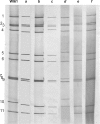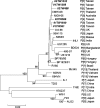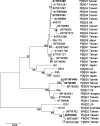Molecular epidemiology of G9 rotaviruses in Taiwan between 2000 and 2002
- PMID: 17021098
- PMCID: PMC1594809
- DOI: 10.1128/JCM.02107-05
Molecular epidemiology of G9 rotaviruses in Taiwan between 2000 and 2002
Abstract
Since the mid-1990s, novel G9 rotaviruses have been detected in many countries, suggesting that G9 is a globally important serotype. The molecular epidemiology of G9 rotaviruses in Taiwan from 2000 to 2002 was investigated in this study. G9 rotavirus first appeared in 2000 with 4 cases and constituted 33.8% and 54.8% of the rotavirus-positive samples in 2001 and 2002, respectively. These G9 strains belonged to P[8]G9, subgroup II, and long electropherotype, except one belonged to P[4]G9, subgroup II, and short electropherotype. Nucleotide sequencing and phylogenetic analysis of 52 Taiwanese G9 rotaviruses showed that the VP7 genes shared a high degree of identity to overseas G9 rotaviruses detected after 1993 and that the VP8* portions of the VP4 genes were more closely related to those of local rotaviruses of other G types. The two P[8]G9 strains with high nucleotide identities in the VP7 and the partial VP4 genes, 01TW591 of Taiwan from 2001 and 95H115 of Japan from 1995, varied in four genes, genes 2, 3, 7, and 8, which was revealed by RNA-RNA hybridization. Representative strains for different RNA patterns were also analyzed in the partial VP2 and VP3 genes; the nucleotide identities were high between Taiwanese G9 strains and local G3 or G2 strains. These results suggested that Taiwanese G9 rotaviruses possibly had evolved through reassortment between overseas G9 strains and circulating rotaviruses of other G types.
Figures







References
-
- Banyai, K., J. R. Gentsch, R. Schipp, F. Jakab, J. Bene, B. Melegh, R. I. Glass, and G. Szucs. 2004. Molecular epidemiology of human P[8],G9 rotaviruses in Hungary between 1998 and 2001. J. Med. Microbiol. 53:791-801. - PubMed
Publication types
MeSH terms
Substances
Associated data
- Actions
- Actions
- Actions
- Actions
- Actions
- Actions
- Actions
- Actions
- Actions
- Actions
- Actions
- Actions
- Actions
- Actions
- Actions
- Actions
- Actions
- Actions
- Actions
- Actions
- Actions
LinkOut - more resources
Full Text Sources
Medical

